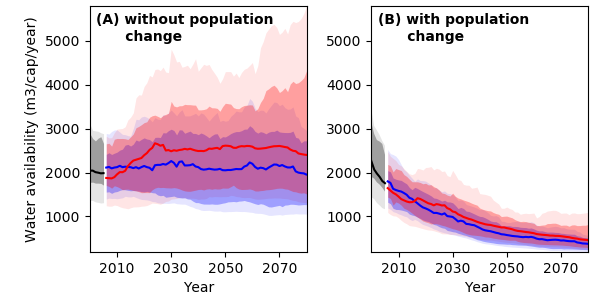Uganda: Water resources
Uganda is known for abundant surface water resources including lakes, rivers and wetlands. 15 % of the country’s total land surface is covered by open water and 13 % by wetlands [13]. However, climate change is likely to impact Uganda’s water resources through variability in precipitation, rising temperatures and drought [14]. Over the last decades, Uganda has experienced an increase in the frequency and intensity of drought, particularly in the Karamoja region in the north-east, impacting agricultural production and food security [15]. Drought also materialises in decreasing water levels in Lake Victoria, which receives 80 % of its fresh water from direct rainfall [16]. In the period from 2004 to 2005, water levels in Lake Victoria dropped by 1.1 m to 10.69 m, reaching the lowest level since 1951 [17]. This drop was attributed to drought, in addition to unsustainable dam operations [17]. Water levels recovered afterwards, reaching a reversed record of 13.42 m in May 2020 [18]. This rise was attributed to continued rainfall, which started in late 2019 and resulted in the displacement of more than 480 000 people across the region [18]. Overall, however, water demand is going to increase due to population growth, putting pressure on Uganda’s water resources [13]. Another main driver behind the draining and degradation of wetlands is agricultural expansion, in addition to growing livestock populations, mining activities and deforestation [13].
Per capita water availability

Current projections of water availability in Uganda display high uncertainty under both GHG emissions scenarios. Assuming a constant population level, multi-model median projections suggest no change in per capita water availability over Uganda by the end of the century under RCP2.6 and an increase of 18 % under RCP6.0 (Figure 8A). Yet, when accounting for population growth according to SSP2 projections4, per capita water availability for Uganda is projected to decline by 80 % by 2080 relative to the year 2000 under both scenarios (Figure 8B). Even though this decline is primarily driven by population growth rather than climate change, it highlights the urgency to invest in water saving measures and technologies for future water consumption as well as protection of watersheds and reservoirs.
Spatial distribution of water availability

Projections of future water availability from precipitation vary depending on the region and scenario (Figure 9). Under RCP2.6, models project a decrease of up to 25 % in southern and eastern Uganda, while under RCP6.0, model agreement is low all over Uganda. This modelling uncertainty, along with the high natural variability of precipitation, contributes to uncertain future precipitation trends all over Uganda.
4 Shared Socio-economic Pathways (SSPs) outline a narrative of potential global futures, including estimates of broad characteristics such as country level population, GDP or rate of urbanisation. Five different SSPs outline future realities according to a combination of high and low future socio-economic challenges for mitigation and adaptation. SSP2 represents the “middle of the road”-pathway.
References
[13] A. I. Rugumayo, E. Jennings, S. Linnane, and B. Misstear, “Water Resources in Uganda,” in Water is Life, G. Honor Fagan, S. Linnane, K. G. McGuigan, and A. I. Rugumayo, Eds. Rugby, United Kingdom: Practical Action Publishing, 2015, pp. 73–96.
[14] USAID, “Climate Vulnerability Profile: Uganda,” Washington, D.C., 2012.
[15] C. Nakalembe, “Characterizing Agricultural Drought in the Karamoja Subregion of Uganda With Meteorological and Satellite-Based Indices,” Nat. Hazards, vol. 91, pp. 837–862, 2018.
[16] J. L. Awange, L. Ogalo, K. H. Bae, P. Were, P. Omondi, P. Omute, and M. Omullo, “Falling Lake Victoria Water Levels: Is Climate a Contributing Factor?,” Clim. Change, vol. 89, pp. 281–297, 2008.
[17] D. Kull, “Connections Between Recent Water Level Drops in Lake Victoria, Dam Operations and Drought,” Nairobi, Kenya, 2006.
[18] FEWS NET, “Seasonal Monitor: More Floods Affect Lake and Riverine Areas as End of the March to May Rainy Season Approaches,” 2020. Online available: https://fews.net/east-africa/seasonal-monitor/may-2020-0 [Accessed: 23-Jun-2020].


